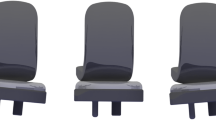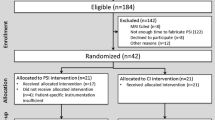Abstract
Purpose
Controversy still exists whether coronal malalignment would influence the long-term survival of total knee arthroplasty (TKA). The hypothesis was that an improved design of the articular surface of modern TKA would prevent the increase in contact stresses and thus decrease the wear even when the implant was placed in a varus position. Two different designs of TKA were compared biomechanically and clinically.
Methods
The patients whose prosthesis was initially placed in a varus alignment by the postoperative long-leg radiographs were selected. Seventeen knees using the NexGen LPS and 16 knees using the MG I were examined. Changes in postoperative alignment and the thickness of the polyethylene insert in a follow-up period of approximately 7 years were evaluated. Additionally, an in vitro biomechanical testing was conducted to measure the contact stresses and the contact area at the tibiofemoral joint of the NexGen LPS and the MG I components mounted on a servohydraulic testing device.
Results
Although the long-leg alignment did not change in NexGen LPS, the varus alignment significantly progressed in MG I. The thickness of polyethylene insert in MG I decreased a significantly greater amount compared with that in NexGen LPS. Biomechanical test showed that the NexGen LPS had a larger contact area and lower mean and peak contact stresses than the MG I significantly.
Conclusion
These results suggest that comprehensive factors of modern prosthesis including improved implant designs could improve the durability of polyethylene insert and decrease implant failures due to component malalignment.




Similar content being viewed by others
References
Berend ME, Ritter MA, Meding JB, Faris PM, Keating EM, Redelman R, Faris GW, Davis KE (2004) Tibial component failure mechanisms in total knee arthroplasty. Clin Orthop Relat Res 428:26–34
Bonner TJ, Eardley WG, Patterson P, Gregg PJ (2011) The effect of post-operative mechanical axis alignment on the survival of primary total knee replacements after a follow-up of 15 years. J Bone Joint Surg Br 93(9):1217–1222
Bugbee WD, Ammeen DJ, Parks NL, Engh GA (1998) 4- to 10-year results with the anatomic modular total knee. Clin Orthop Relat Res 348:158–165
Chauhan SK, Clark GW, Lloyd S, Scott RG, Breidahl W, Sikorski JM (2004) Computer-assisted total knee replacement. A controlled cadaver study using a multi-parameter quantitative CT assessment of alignment (the Perth CT Protocol). J Bone Joint Surg Br 86(6):818–823
D’Lima DD, Hermida JC, Chen PC, Colwell CW Jr (2001) Polyethylene wear and variations in knee kinematics. Clin Orthop Relat Res 392:124–130
Ezzet KA, Hermida JC, Steklov N, D’Lima DD (2012) Wear of polyethylene against oxidized zirconium femoral components effect of aggressive kinematic conditions and malalignment in total knee arthroplasty. J Arthroplasty 27(1):116–121
Fang DM, Ritter MA, Davis KE (2009) Coronal alignment in total knee arthroplasty: just how important is it? J Arthroplasty 24:39–43
Kuster MS, Stachowiak GW (2002) Factors affecting polyethylene wear in total knee arthroplasty. Orthopedics 25:s235–s242
Liau JJ, Cheng CK, Huang CH, Lo WH (2002) The effect of malalignment on stresses in polyethylene component of total knee prostheses—a finite element analysis. Clin Biomech (Bristol, Avon) 17(2):140–146
Lombardi AV Jr, Berend KR, Ng VY (2011) Neutral mechanical alignment: a requirement for successful TKA: affirms. Lombardi Orthop 34(9):e504–e506
Longstaff LM, Sloan K, Stamp N, Scaddan M, Beaver R (2009) Good alignment after total knee arthroplasty leads to faster rehabilitation and better function. J Arthroplasty 24(4):570–578
Matsuda S, Miura H, Nagamine R, Urabe K, Harimaya K, Matsunobu T, Iwamoto Y (1999) Changes in knee alignment after total knee arthroplasty. J Arthroplasty 14(5):566–570
Matsuda S, Whiteside LA, White SE (1999) The effect of varus tilt on contact stresses in total knee arthroplasty: a biomechanical study. Orthopedics 22(3):303–307
Matziolis G, Adam J, Perka C (2010) Varus malalignment has no influence on clinical outcome in midterm follow-up after total knee replacement. Arch Orthop Trauma Surg 130(12):1487–1491
Pang HN, Yeo SJ, Chong HC, Chin PL, Ong J, Lo NN (2011) Computer-assisted gap balancing technique improves outcome in total knee arthroplasty, compared with conventional measured resection technique. Knee Surg Sports Traumatol Arthrosc 19(9):1496–1503
Parratte S, Pagnano MW, Trousdale RT, Berry DJ (2010) Effect of postoperative mechanical axis alignment on the fifteen-year survival of modern, cemented total knee replacements. J Bone Joint Surg Am 92(12):2143–2149
Perillo-Marcone A, Barrett DS, Taylor M (2000) The importance of tibial alignment: finite element analysis of tibial malalignment. J Arthroplasty 15(8):1020–1027
Pijls BG, Van der Linden-Van der Zwaag HM, Nelissen RG (2012) Polyethylene thickness is a risk factor for wear necessitating insert exchange. Int Orthop 36(6):1175–1180
Ritter MA, Faris PM, Keating EM, Meding JB (1994) Postoperative alignment of total knee replacement. Its effect on survival. Clin Orthop Relat Res 299:153–156
Ritter MA, Davis KE, Meding JB, Pierson JL, Berend ME, Malinzak RA (2011) The effect of alignment and BMI on failure of total knee replacement. J Bone Joint Surg Am 93(17):1588–1596
Taylor M, Tanner KE (1997) Fatigue failure of cancellous bone: a possible cause of implant migration and loosening. J Bone Joint Surg Br 79(2):181–182
Acknowledgments
We thank Hiroyuki Nakahara M.D. and Shinya Kawahara M.D. for assistance in the interobserver trial.
Author information
Authors and Affiliations
Corresponding author
Rights and permissions
About this article
Cite this article
Nishikawa, K., Okazaki, K., Matsuda, S. et al. Improved design decreases wear in total knee arthroplasty with varus malalignment. Knee Surg Sports Traumatol Arthrosc 22, 2635–2640 (2014). https://doi.org/10.1007/s00167-013-2506-z
Received:
Accepted:
Published:
Issue Date:
DOI: https://doi.org/10.1007/s00167-013-2506-z




